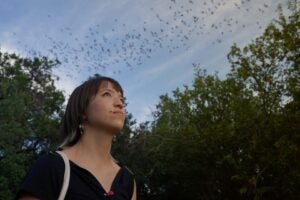AUSTIN, Texas– Recent developments at Brackenridge Field Laboratory (BFL) at UT Austin represent small but important benchmarks toward the ultimate goal of long-term biological control of imported fire ants, according to Dr. Lawrence Gilbert, director of the laboratory and of the research project and director of the zoology department at UT Austin.
“It is little known that we carried out the first field releases of Brazilian phorid flies (genus Pseudacteon) in North America here in Austin from late 1995 through summer 1996. Thanks to a record drought, the attempt to establish these tiny ant enemies failed. A second round of release attempts in May/June 1997 resulted in several sightings of phorid flies attacking fire ant workers outdoors in Texas, a phenomenon previously unknown to this population since their ancestors caught the boat to Alabama over 60 years ago,” said Gilbert.
“One thing we learned from these efforts, aside from humility and patience, is the need for a way to build up phorid populations protected from the harsh Texas droughts, freezes and winds that have apparently kept the lid on hoped-for phorid population explosions,” Gilbert said.
That brings up another step the Texas group has taken with the help of hunters and ranchers acting through the Turkey Stamp fund of Texas Parks and Wildlife Department; the Ewing Halsell, Fondren and Robert and Helen Kleberg foundations; and the Houston Livestock Show and Rodeo. The world’s first facility designed specifically to rear and maintain large populations of ant-infesting phorid flies for experimental studies and field releases is nearing completion four miles from the UT campus at BFL in Austin.
“Our difficulties establishing phorid populations over the past two years increased our seriousness in pushing this facility to completion,” Gilbert said. “Our colleague, Sanford Porter at USDA Gainesville in Florida, probably won’t need to jump-start his fly populations, given a climate closer to what they experience in Brazil. We will be excited if his releases in July 1997 turn out to be more successful than ours have been.
“However, Texas is Texas, with tougher weather and many, many more fire ants per acre. Any success in Florida won’t help much in Texas. We’ll have to cope with our own unique situation.”Perhaps the most unusual development, according to Gilbert, is the enshrinement of UT Austin’s efforts to use phorid flies against fire ants in a spring 1996 episode of the nationally syndicated cartoon, “King of the Hill,” which focuses on life in the fictitious Texas town of Arlen. Gilbert said he believes that sometime Austinite Mike Judge, the creator of the series, was influenced by local stories on the work at BFL.
“We must not understate the importance of ant biocontrol entering the consciousness of the general public through such a medium,” Gilbert says. “For phorid flies to ultimately control fire ants, everyone will have to be aware of features of their basic biology (such as their extreme specificity to the imported pest) and of the need to leave native ants alone, since phorids act indirectly by shifting the balance of competition. Hank Hill got the ball rolling like no scientific paper could.”For additional information, contact Gilbert at (512) 471-7131, or check his website at http://uts.cc.utexas.edu/~gilbert/research/fireants/.
He said that beginning in September of this year a state government funding program, ” The Texas Imported Fire Ant Research & Management Plan,” totaling $2.5 million per year, will begin providing support to cooperating programs at Texas A&M and Texas Tech University and the University of Texas.
The plan is administered through the Texas Experiment Station in College Station.For further information about the plan, visit the program website at: http://fireant.tamu.edu/.



